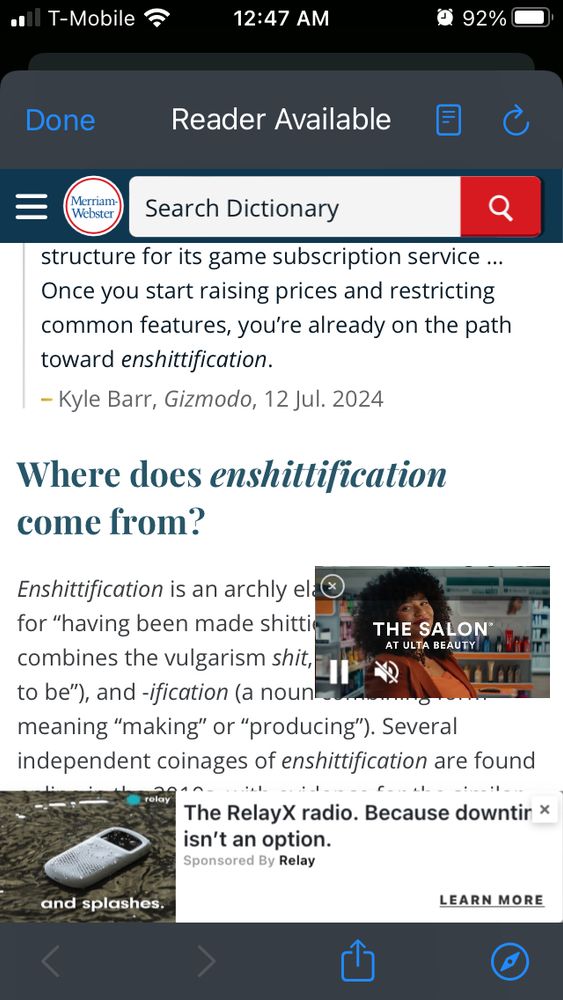
~ Past: rendering lead @figma.com, indie VR dev, founder @ Workflowy, search backend @ Google, Quake modder
miketuritzin.com
This type of thing is really simple in my engine - just spawn an SDF capsule subtraction that is locked to the player's view.
github.com/KhronosGroup...
The lib is not super well documented but pretty easy to use and hook up to WebGPU - e.g., to load HDR cubemaps, 3D textures, etc.

github.com/KhronosGroup...
The lib is not super well documented but pretty easy to use and hook up to WebGPU - e.g., to load HDR cubemaps, 3D textures, etc.
liveplusplus.tech/features.html
liveplusplus.tech/features.html
Both in terms of algorithms and GLSL character minimization!
blog.pkh.me/p/45-code-go...
Both in terms of algorithms and GLSL character minimization!
blog.pkh.me/p/45-code-go...
Distances are reconstructed via trilinear interpolation of cached values on a grid.
This is the equivalent of what was shown in my earlier 2D animations (see below!)
Distances are reconstructed via trilinear interpolation of cached values on a grid.
This is the equivalent of what was shown in my earlier 2D animations (see below!)
Make a tunnel, walk through it, and then close it up behind you.
Going to experiment with this for gameplay in a mining context.
Make a tunnel, walk through it, and then close it up behind you.
Going to experiment with this for gameplay in a mining context.
- Negative (interior) samples of the analytic SDF are blue, positive (exterior) samples are orange.
- Circles are drawn around samples to show distance magnitude.
- Intermediate bilinear interp samples / segments are drawn.
1/
- Negative (interior) samples of the analytic SDF are blue, positive (exterior) samples are orange.
- Circles are drawn around samples to show distance magnitude.
- Intermediate bilinear interp samples / segments are drawn.
1/
- White line is the analytic SDF curve.
- Sparsely-allocated cells (and distance samples) are shaded.
- Yellow line in the reconstructed SDF curve from cached samples (via bilinear interpolation of distances).
- White line is the analytic SDF curve.
- Sparsely-allocated cells (and distance samples) are shaded.
- Yellow line in the reconstructed SDF curve from cached samples (via bilinear interpolation of distances).
"Gangs of Program Instances" has a certain menacing ring to it 😁

"Gangs of Program Instances" has a certain menacing ring to it 😁
So my quick solution is to dump literal C++ code that creates all scene objects. Then copy/paste into my init code😂
So my quick solution is to dump literal C++ code that creates all scene objects. Then copy/paste into my init code😂

This type of thing is really simple in my engine - just spawn an SDF capsule subtraction that is locked to the player's view.
This type of thing is really simple in my engine - just spawn an SDF capsule subtraction that is locked to the player's view.
And the hole grows bigger when it consumes cubes, because that's what holes do (obviously).
And the hole grows bigger when it consumes cubes, because that's what holes do (obviously).
This took a while because I didn't implement "normal" cascaded shadow maps (via frustum slices) but rather world-space cascades that are updated in chunks as the camera moves, and incrementally when the scene changes.
1/
This took a while because I didn't implement "normal" cascaded shadow maps (via frustum slices) but rather world-space cascades that are updated in chunks as the camera moves, and incrementally when the scene changes.
1/
NRI is intended to be a low-level interface wrapping D3D12 and Vulkan, whereas NVRHI also wraps these APIs but simplifies some ..
NRI is intended to be a low-level interface wrapping D3D12 and Vulkan, whereas NVRHI also wraps these APIs but simplifies some ..
Shows how powerful having insane technical skills can be.
Shows how powerful having insane technical skills can be.
One of the benefits of using SDFs - just eval the terrain SDF to get distance to surface for any point!
One of the benefits of using SDFs - just eval the terrain SDF to get distance to surface for any point!
The previous function I was using (which is the common one) blends the material around the surface influence area, and so would have no effect below ground.
The previous function I was using (which is the common one) blends the material around the surface influence area, and so would have no effect below ground.
This ended up being a bigger project than expected, as I decided to render world-space shadow map cascades that update/"scroll" incrementally as the camera moves.
The benefit of this is that very little work needs to be done every frame!
This ended up being a bigger project than expected, as I decided to render world-space shadow map cascades that update/"scroll" incrementally as the camera moves.
The benefit of this is that very little work needs to be done every frame!


